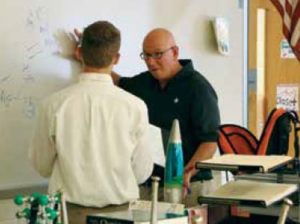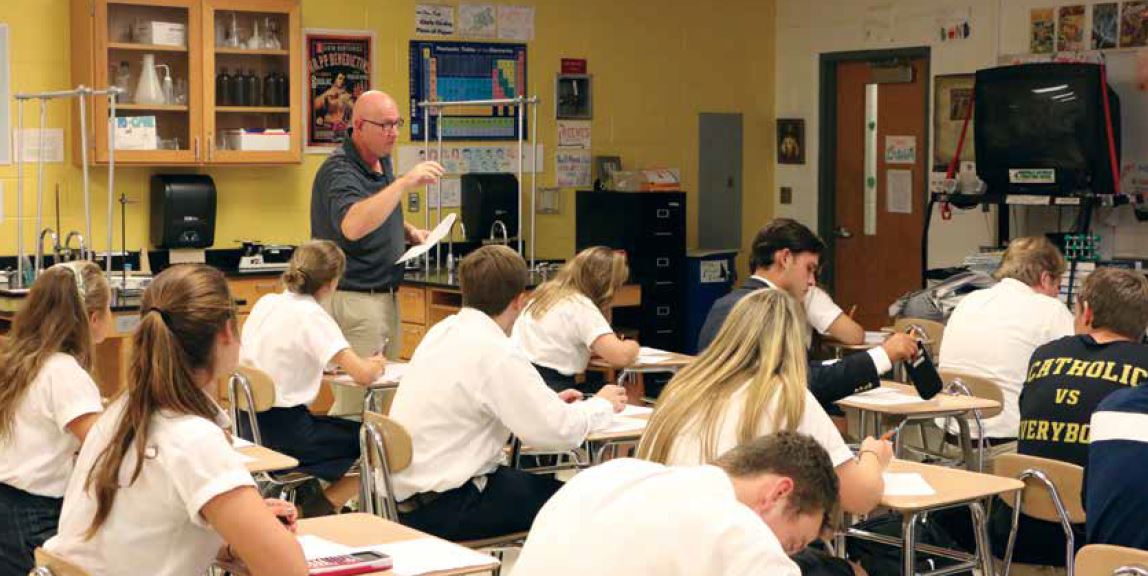By Bill Brewer
Looking around Dr. Kelly Kearse’s classroom at Knoxville Catholic High School, you can almost hear the big bang when faith and science collide.
There are the chemical equations on the white board waiting to be balanced. There is the periodic table of elements on the wall. And there is the picture of Albert Einstein — right next to the crucifix.
There’s also a crucifix poster on the wall with the words, “Most high and glorious God, bring light to the darkness of my heart.” Then there’s the picture of the Sacred Heart of Jesus and the Proverbs verse, “When pride cometh, then cometh shame, but with the lowly is wisdom.”
Dr. Kearse, who teaches chemistry at KCHS and considers himself a strong Catholic, embraces the collision. He teaches that religion and science aren’t at odds at all, despite the contentions of secular experts. In fact, he believes they complement each other.
So when a discovery takes place that moves science forward, such as the headline-grabbing confirmation last month of Einstein’s theory of relativity, where almost imperceptible gravitational waves in space were detected, his enthusiasm for his vocation soars.
But that enthusiasm can’t compare to Dr. Kearse’s excitement at being among the scientists doing research on another of the world’s great scientific mysteries — the Shroud of Turin.
It’s his hope that science and technology will continue to advance to the point where there is proof that the image on the shroud and the ancient stains on the relic are from Christ.
The longtime educator, who has a Ph.D. in Microbiology and Immunology, is working to prove his point with ongoing research into the Shroud of Turin, where some of the most accomplished scientists in the world have been trying to prove, or disprove, that the image on the shroud is that of Jesus Christ.
Dr. Kearse’s research into the shroud is years in the making and is part of a much larger international project by scientists to study the historic burial cloth that Christians believe covered Christ’s body after he was crucified.
And now the chemistry teacher’s studies have taken him to the shroud itself.
After taking part in the St. Louis Shroud Conference in 2014 and giving a presentation on the critical reevaluation and strength of evidence of blood stains, Dr. Kearse traveled to Turin last summer to view the shroud in person during a public display. It was his first time to see it firsthand.
Pope Francis called for an early exposition of the shroud in 2015, ahead of its next scheduled showing in 2025. The last exposition was in 2010. Only a pope can request an early exposition of the shroud.
Dr. Kearse has been trying for nearly 30 years to get to Turin for a public showing of the shroud, and was not disappointed.
He spent 15 minutes with the shroud in five-minute increments, standing 10 feet away. Another four visits were spent viewing the shroud from the church sanctuary for 30 minutes to an hour each time. He spent two weeks in Turin. The viewing and research gave him a new perspective after spending years examining tiny remnants of the shroud under a microscope.
“I was surprised at how close to the shroud we were able to get,” Dr. Kearse said, noting that, in Turin, Italy, the shroud was contained in a special reliquary that was a lighted, atmosphere-controlled display cabinet at the Cathedral of St. John the Baptist. It was on public display from April 19 through June 24, and it was viewed by 2 million people.
“The tour group we went with included the scientist who organized the 1978 scientific expedition. He was with us every day leading discussions,” Dr. Kearse said, referring to a groundbreaking congregation of leading world scientists who joined together to conduct an in-depth inspection of the shroud that kick-started modern scientific investigation.
Dr. Kearse’s personal viewing of the shroud last summer follows his personal study of pieces of the shroud that were trimmed from the linen icon during the 1978 scientific investigation. Dr. Kearse and other investigators have run tests on blood samples from the shroud to determine if they are human.
While science has made gigantic leaps since 1978, and advancements have moved researchers much closer to identifying the image superimposed on the shroud, blood tests remain inconclusive as to whether the image is a human male.
“Is it really blood? If it is blood, what type of blood?
And if it is blood, then whose blood?” Dr. Kearse asked.
“I believe there is more than one type of evidence that it is really blood.”
Scientists have tested for albumin and immunoglobulin, two major proteins in blood, and Dr. Kearse believes the evidence is strong enough to conclude the stains are blood. But that is about as far as the science will take them at this point.
“I really believe the strongest you can say is it is primate blood,” he said, noting that humans are primates. He also said human male DNA was found on the shroud, but there isn’t a way to isolate where the DNA originated because so many people have handled the shroud through the years.
 Dr. Kearse strongly leans toward the scientific opinion that the image is Christ. He arrives at that conclusion based on the evidence available and the fact that scientists have tried unsuccessfully to prove the image isn’t Christ. Now, after viewing the entire shroud, Dr. Kearse is even more convinced that faith and science are not mutually exclusive.
Dr. Kearse strongly leans toward the scientific opinion that the image is Christ. He arrives at that conclusion based on the evidence available and the fact that scientists have tried unsuccessfully to prove the image isn’t Christ. Now, after viewing the entire shroud, Dr. Kearse is even more convinced that faith and science are not mutually exclusive.
“Seeing up close the blood in context with the image puts the shroud in the faith context. The science and the faith are very compatible to me,” he said.
Upon seeing the shroud in person, Dr. Kearse was surprised to see how red the blood stains still are at the exact points where Jesus Christ’s wounds have been described in the Bible. He said that without some kind of cataclysmic event, the blood over time would turn brown or black as the blood breaks down.
“Some people say it is too red because of the trauma of the body and excess bilirubin, which causes blood to be red and stay red. Another person says carbon monoxide has bound to the blood, causing the blood to stay red. Carbon monoxide tends to be temporary and it doesn’t match over time,” he said. “Another theory is there was some kind of energetic, supernatural event that bound the blood red.”
The “shroud crowd” believes bilirubin is responsible.Dr. Kearse’s research is leading him to examine how blood responds to various external stimuli.
“With each one of these theories, I try to keep an open mind. Maybe it is a combination,” he said.
But where science and faith intersect, when it comes to the Shroud of Turin, Dr. Kearse believes science dead-ends and faith takes over.
“I don’t think science can ever conclusively prove the shroud is real. I think science at its best can show consistencies. Science hasn’t been able to disprove that it isn’t the shroud,” Dr. Kearse said.
“In 1978, top scientists from Los Alamos and other research sites were confident they could prove the shroud was painted (which was disproved). The science at its best can only take you so far. But then there is a leap of faith. The Scriptures prove there was a shroud from Jesus’ body,” he added.
Dr. Kearse, who has been a teacher for 30 years, 15 of those at KCHS, notes that there are numerous stories of agnostic scientists being converted to Christianity because of the shroud science. And that shroud science continues to motivate him, just as his classroom work with students does.
“The message of what (the shroud) represents is the most important thing. Seeing the shroud in person really stoked the scientific fire, and with faith it enhances my beliefs even more, just like the veneration of the Cross.”

